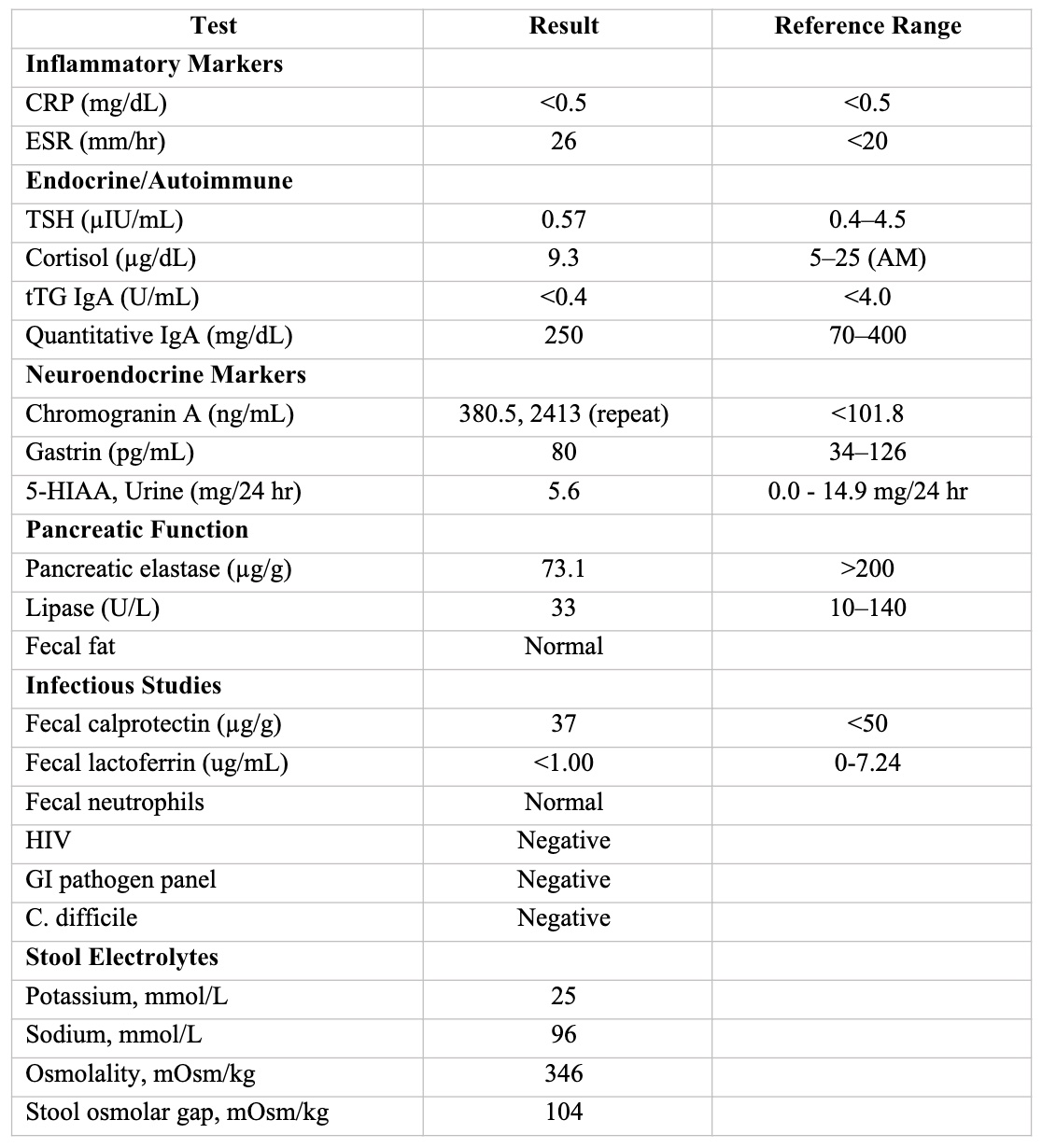Tuesday Poster Session
Category: Small Intestine
P6291 - Chronic Diarrhea in a Patient with Exocrine Pancreatic Insufficiency: Unmasking a VIPoma
Tuesday, October 28, 2025
10:30 AM - 4:00 PM PDT
Location: Exhibit Hall

Benjamin L. Robinson, DO (he/him/his)
Atrium Health Carolinas Medical Center
Charlotte, NC
Presenting Author(s)
Benjamin L. Robinson, DO1, Eva M. Kinzer, FNP1, Erica R. Dacosta, PA-C2, Baha Moshiree, MD1
1Atrium Health Carolinas Medical Center, Charlotte, NC; 2Atrium Health, Charlotte, NC
Introduction: Among the rare but important causes of chronic diarrhea is vasoactive intestinal peptide-secreting tumor (VIPoma). We present a case of chronic diarrhea ultimately diagnosed as VIPoma, highlighting key diagnostic considerations and the importance of early recognition.
Case Description/
Methods: A 54-year-old man with gastroesophageal reflux disease and exocrine pancreatic insufficiency (EPI) presented with chronic, watery diarrhea occurring more than ten times daily, predominantly postprandial, and associated with nocturnal fecal incontinence and a 27 kg weight loss over six months. Previous bidirectional endoscopies were non-diagnostic, and trials of pancreatic enzyme replacement, antimotility agents, rifaximin, and bile acid sequestrants provided no relief. A comprehensive evaluation for infectious, inflammatory, osmotic, and secretory causes was unrevealing (Table 1). An initial chromogranin A (CgA) level was elevated at 380.5 ng/mL while the patient was on a proton pump inhibitor (PPI) for severe esophagitis; a repeat level increased further to 2,413 ng/mL while still on PPI therapy. Repeat bidirectional endoscopies were performed to evaluate for maldigestion, celiac disease, amyloidosis, and atypical infections, with negative findings. He was referred to the GI motility clinic for ongoing symptoms and concern for irritable bowel syndrome with diarrhea (IBS-D). Stool osmolality was 346 mOsm/kg, with an osmolar gap of 104 mOsm/kg, in the setting of EPI. Persistent diarrhea despite total parenteral nutrition and the absence of oral intake raised concern for a secretory process. Cross-sectional imaging of the chest, abdomen, and pelvis was unremarkable, but serum vasoactive intestinal peptide was elevated at 84.6 pg/mL (reference: 0.0–58.8), prompting Gallium-68 DOTATATE PET/CT to localize a VIP-secreting tumor.
Discussion: Given their rarity, VIPomas are often overlooked in the differential diagnosis of chronic diarrhea, particularly in patients with coexisting gastrointestinal comorbidities, as in this case. Although elevated serum CgA levels can be seen in VIPomas, they may be falsely elevated by PPI use. However, in this case, there was a sixfold increase in CgA level on repeat testing despite this consideration, further supporting the suspicion of a VIPoma. This case underscores the importance of considering VIPomas in the workup of chronic secretory diarrhea, particularly when symptoms are refractory to standard therapies and associated with significant malnutrition.

Figure: Table 1. Evaluation of chronic diarrhea
Disclosures:
Benjamin Robinson indicated no relevant financial relationships.
Eva Kinzer indicated no relevant financial relationships.
Erica Dacosta indicated no relevant financial relationships.
Baha Moshiree indicated no relevant financial relationships.
Benjamin L. Robinson, DO1, Eva M. Kinzer, FNP1, Erica R. Dacosta, PA-C2, Baha Moshiree, MD1. P6291 - Chronic Diarrhea in a Patient with Exocrine Pancreatic Insufficiency: Unmasking a VIPoma, ACG 2025 Annual Scientific Meeting Abstracts. Phoenix, AZ: American College of Gastroenterology.
1Atrium Health Carolinas Medical Center, Charlotte, NC; 2Atrium Health, Charlotte, NC
Introduction: Among the rare but important causes of chronic diarrhea is vasoactive intestinal peptide-secreting tumor (VIPoma). We present a case of chronic diarrhea ultimately diagnosed as VIPoma, highlighting key diagnostic considerations and the importance of early recognition.
Case Description/
Methods: A 54-year-old man with gastroesophageal reflux disease and exocrine pancreatic insufficiency (EPI) presented with chronic, watery diarrhea occurring more than ten times daily, predominantly postprandial, and associated with nocturnal fecal incontinence and a 27 kg weight loss over six months. Previous bidirectional endoscopies were non-diagnostic, and trials of pancreatic enzyme replacement, antimotility agents, rifaximin, and bile acid sequestrants provided no relief. A comprehensive evaluation for infectious, inflammatory, osmotic, and secretory causes was unrevealing (Table 1). An initial chromogranin A (CgA) level was elevated at 380.5 ng/mL while the patient was on a proton pump inhibitor (PPI) for severe esophagitis; a repeat level increased further to 2,413 ng/mL while still on PPI therapy. Repeat bidirectional endoscopies were performed to evaluate for maldigestion, celiac disease, amyloidosis, and atypical infections, with negative findings. He was referred to the GI motility clinic for ongoing symptoms and concern for irritable bowel syndrome with diarrhea (IBS-D). Stool osmolality was 346 mOsm/kg, with an osmolar gap of 104 mOsm/kg, in the setting of EPI. Persistent diarrhea despite total parenteral nutrition and the absence of oral intake raised concern for a secretory process. Cross-sectional imaging of the chest, abdomen, and pelvis was unremarkable, but serum vasoactive intestinal peptide was elevated at 84.6 pg/mL (reference: 0.0–58.8), prompting Gallium-68 DOTATATE PET/CT to localize a VIP-secreting tumor.
Discussion: Given their rarity, VIPomas are often overlooked in the differential diagnosis of chronic diarrhea, particularly in patients with coexisting gastrointestinal comorbidities, as in this case. Although elevated serum CgA levels can be seen in VIPomas, they may be falsely elevated by PPI use. However, in this case, there was a sixfold increase in CgA level on repeat testing despite this consideration, further supporting the suspicion of a VIPoma. This case underscores the importance of considering VIPomas in the workup of chronic secretory diarrhea, particularly when symptoms are refractory to standard therapies and associated with significant malnutrition.

Figure: Table 1. Evaluation of chronic diarrhea
Disclosures:
Benjamin Robinson indicated no relevant financial relationships.
Eva Kinzer indicated no relevant financial relationships.
Erica Dacosta indicated no relevant financial relationships.
Baha Moshiree indicated no relevant financial relationships.
Benjamin L. Robinson, DO1, Eva M. Kinzer, FNP1, Erica R. Dacosta, PA-C2, Baha Moshiree, MD1. P6291 - Chronic Diarrhea in a Patient with Exocrine Pancreatic Insufficiency: Unmasking a VIPoma, ACG 2025 Annual Scientific Meeting Abstracts. Phoenix, AZ: American College of Gastroenterology.
